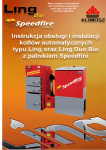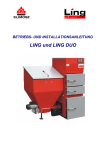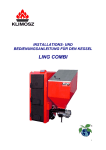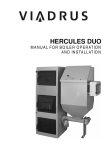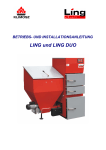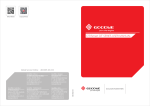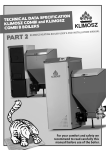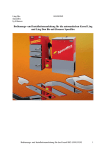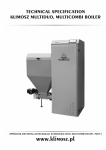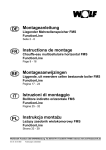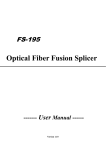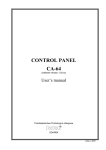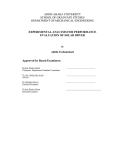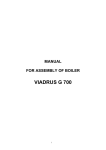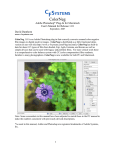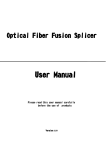Download LING DUO 15, 25, 35, 50 and 75
Transcript
USER’S MANUAL FOR BOILER LING DUO 15, 25, 35, 50 and 75 Review Date: 2009.01.22 Dear Sir/Madame Thank you for choosing the retort boiler LING DUO, designed in accordance with the latest standards valid for heat industry. In order to understand principles of correct and economic exploitation of the boiler, as well as to be safe and comfortable, please read this User’s manual for boiler carefully. Please, conform to presented information and rules in order to provide long-term and reliable work of the boiler. ECOLOGICAL HEATING UNITS for communal economy Word and device marks are registered in Poland and in the territory of the European Union, Use of these marks for any purpose, without a written permission previously obtained from KLIMOSZ Sp. Z o.o. is prohibited. ® Industrial pattern for retort boiler Ling is protected by means of Industrial Pattern Register Law no. 9134, titled Automatic Retort Boiler, issued by UPRP for KLIMOSZ Sp. Z o.o. Manufacture or trade with units similar to the ® Ling boiler is prohibited and shall be recognized as a prohibited competitor’s act which may mislead Clients. Text of this Manual for Boiler constitutes property of KLIMOSZ Sp. Z o.o., reproducing, copying and publishing of the text without a consent previously obtained from KLIMOSZ Sp. Z o.o. is prohibited All copyright to the text form materials, graphic form materials and multimedia materials available on the www.klimosz.pl website and in technical materials, their translations, related training materials and promotional materials of KLIMOSZ Sp. Z o.o. belong to KLIMOSZ Sp. Z o.o. Copying, publishing and distribution in any way, without a written form consent previously obtained from Member of the KLIMOSZ Sp. Z o.o. Managing Board constitute violation of KLIMOSZ Sp. Z o.o. copyright. Consequently, as an offence it shall be decided by a court relevant in terms of KLIMOSZ Sp. Z o.o. headquarters. The manufacturer reserves its rights to implement structural changes of boiler. User’s Manual for LING DUO boiler 2 Dear users of the boiler. For your safety and comfort, please, send back correctly filled in (all positions filled and all stamps) last copy of the Warranty Card as well as Confirmation of Quality and Completeness of the boiler (last page of this Manual for Boiler) into the address below: Viadrus Centrum Serwisowe 83 Rybnicka Street 44-240 śory Silesia tel. 032 475 22 84 fax 032 434 60 75 Manufacturer Zakład Produkcyjno Handlowy TEKLA 3 Poddane Street Strumień Sending the Warranty Card back shall enable registering You at our database of the LING DUO boiler users and provide you with quick and reliable service. IMPORTANT! ! ! HEREBY WE INFORM THAT FAILING TO SEND THE WARRANTY CARD OR INCOMPLETE OR INCORRECTLY FILLED IN CARD AS WELL AS CONFIRMATION FOR QUALITY AND COMPLETENESS OF THE BOILER WITHIN: TWO WEEKS AS OF A DATE OF THE BOILER ASSEMBLY, BUT NOT EXCEEDING 6 MONTHS FROM PURCHASE DATE, RESULTS IN LOSS OF WARRANTY FOR SPARE PARTS AND ALL SUBASSEMBLIES OF THE BOILER. LOSS OF WARRANTY SHALL RESULT IN DELAY OF REPAIRS OF A BOILER AND NECESSITY TO PAY ALL REPAIRS TOGETHER WITH TRAVEL COSTS OF A SERVICEMAN BY A USER. Text of this Manual for Boiler belongs to KLIMOSZ Z o.o., its reproducing, copying and publishing without a consent previously obtained from KLIMOSZ Sp. Z o.o. is prohibited. Thank you for your attention, Best regards, KLIMOSZ Sp. z o.o. 3 User’s Manual for LING DUO boiler Warning signs and assigned meanings 5 1. Use and advantages of the boiler 5 2. Technical Data for LING DUO 6 3. Description of the boiler 8 3.1. Boiler’s structure 8 3.2. Protective and regulative fittings 17 3.3. Boiler’s equipment and instruments 18 4. Location and assembly of the boiler in a boiler’s room 19 4.1. Codes and norms 19 4.2. Requirements concerning assembly of the boiler in a boiler’s room 19 5. Start-up of the boiler – manual for service company 21 5.1. Control activities before a start-up 21 5.2. Assembly of fire-proof catalyst 22 5.3. Start-up of the boiler 22 23 6. User’s manual for boiler 6.1. Remarks for automatic combustion 23 6.2. Remarks for manual combustion 26 7. Manual for boiler liquidation after its lifecycle has expired. 29 8. Terms and conditions for the warranty and liability for product’s defects 30 9. Recommended scheme of connection of the boiler to the heating system 32 10. LING DUO boilers’ power settings 34 11. Potential failures and ways of repair 39 12. Electric diagram for controller connection 43 13. Certificate for ecological safety 44 14. Attachment to a warranty card of the boiler – annual maintenance service 46 User’s Manual for LING DUO boiler 4 15. Warranty cards and confirmations of quality and completeness of the boiler 5 User’s Manual for LING DUO boiler 48 Warning signs and their meanings information sign warning of electric shock warning of potential hazard for health or life 1. Use and advantages of the boiler Excess pressure LING DUO boiler is a heating boiler designed to combust solid fuels in an automatic way and traditional one. Range of powers of the boilers enables heating single family and multi family houses, small holiday resorts, workshops etc. LING DUO PLUS additionally enables connection of automatic shot lighter for pellets. Advantages of the boiler - automatic boiler’s work; - opportunity for work due to weather-based mode (only hot utility water heated); - opportunity for return temperature regulation due to control by a servo on a four way valve; - opportunity to connect room-thermostat, wireless or cable; - opportunity to connect automatic shot light for pellets; - opportunity to combust bio-mass in form of granules made of sawdust (pellet) or oat seeds; - opportunity to combust wood and coal (thick sort) on additional emergency furnace; - simple and quick service and maintenance service; - ecological exploitation; - low level of hazardous substances in fumes; - high productivity. User’s Manual for LING DUO boiler 6 2. Technical Data for LING DUO Table no. 1 Dimensions and technical parameters of the LING DUO boiler. Parameter Nominal power – automatic mode Fuel coal (pea coal) Fuel bio-mass – pellets Maximal power – coal Efficiency – eco-pea Mass Use of fuel at nominal power – continuous heating (pea coal 27MJ/kg) Use of fuel at nominal power – continuous heating (pellets 16MJ/kg) - Water volume Diameter of fumes outlet Heating area of the boiler SI kW kW kW % kg 15 15 15 13 15 25 25 25 22 25 365 400 kg/h 2,16 3,60 kg/h 3,24 dm3 mm m2 60 145 1,7 185 / 280 1320 x 870 x 1360 300 x 400 x 370 dm3 Storage bin volume Boiler’s dimensions with the storage bin: width depth height Upper chamber’s dimensions (manual): width depth height Water maximal working pressure Water maximal trial pressure Recommended working temperature for heating water Maximal working temperature for heating water Approximate combustion time at nominal power (coal) Approximate combustion time at nominal power (bio-mass) Minimal temperature of water returning to the boiler Maximal permitted level of heating material Safety valve Noise level Chimney draught Connections of the boiler: - heating water - returning water Voltage Electric energy consumption (air blower + motor) Electric energy consumption (shot light - option) Electric insulation mm mm 50 50 50 44 50 75 75 75 66 75 520 620 5,04 7,20 10,80 5,40 7,56 10,80 16,20 90 145 2,9 185 / 280 1330 x 900 x 1470 360 x 470 x 420 115 145 3,75 185 / 280 1425 x 900 x 1466 420 x 470 x 420 2.0 3,0 65 ÷ 80 130 145 5,0 175 200 7,7 320/92 0 1600 x 1020 x 1730 600 x 520 x 420 bar bar °C °C 35 35 35 30 35 up to 92 430 280 1475 x 900 x 1570 480 x 470 x 420 90 5 ÷ 12 h 3÷8 h 55 °C m bar dB Pa Js Js 25 2,0 below 65 (A) 10 ÷ 20 G1½” G1½” 1 PEN ~ 50 Hz 175 400 IP 40 W W Table no. 2 Thermal and technical parameters of the LING DUO 15 boiler (automatic mode). Parameter Nominal power Power regulation scope Fumes’ temperature Flow of fumes in the smoke conduit - at nominal power - at minimal power 7 SI Hard coal kW kW °C 15 6 ÷ 15 100 ÷ 230 Pellets (oats) 13 (11) 9 ÷ 22 100 ÷ 200 kg /s kg /s 0,009 0,003 0,010 0,006 User’s Manual for LING DUO boiler 20 ÷ 30 G2” G2” 235 Table no. 3 Thermal and technical parameters of the LING DUO 25 boiler (automatic mode). Parameter Nominal power Power regulation scope Fumes’ temperature Flow of fumes in smoke conduit - at nominal power - at minimal power SI Hard coal kW kW °C 25 10 ÷ 25 100 ÷ 230 Pellets (oats) 22 (20) 9 ÷ 22 100 ÷ 200 kg /s kg /s 0,014 0,005 0,015 0,010 Table no. 4 Thermal and technical parameters of the LING DUO 35 boiler (automatic mode). Parameter Nominal power Power regulation scope Fumes’ temperature Flow of fumes in the smoke conduit - at nominal power - at minimal power Table no. 5 Hard coal kW kW °C 35 14 ÷ 35 100 ÷ 230 Pellets (oats) 32 (30) 13 ÷ 32 100 ÷ 200 kg /s kg /s 0,018 0,007 0,013 0,02 Thermal and technical parameters of the LING DUO 50 boilers (automatic mode). Parameter Nominal power Power regulation scope Fumes’ temperature Flow of fumes in the smoke conduit - at nominal power - at minimal power Table no. 6 SI SI Hard coal kW kW °C 50 20 ÷ 50 100 ÷ 230 Pellets (oats) 44 18 ÷ 44 100 ÷ 200 kg /s kg /s 0,023 0,009 0,026 0,016 Thermal and technical parameters of the LING DUO 75 boilers (automatic mode). Parameter Nominal power Power regulation scope Fumes’ temperature Flow of fumes in the smoke conduit - at nominal power - at minimal power SI Hard coal kW kW °C 75 30 ÷ 75 100 ÷ 230 Pellets (oats) 66 27 ÷ 17,5 100 ÷ 200 kg /s kg /s 0,032 0,013 0,036 0,020 User’s Manual for LING DUO boiler 8 Fuel parameters: • granulation 5 ÷ 25mm ; r • calorific value Qi > 15MJ / kg ; • • ash content A < 12% ; humidity content W r < 15% (pea-coal, pellets, oat seeds), wood < 20 %; r • • • • volatile particles content V r > 28% ; Softening point (ash) t A > 1200 o C ; caking properties RI < 5 (max 10); little swelling. Attention!!! LING DUO boiler is not designed to combust wastes and prohibited fuels must not be combusted in it. Table no. 7 Recommended fuel. Fuel Type of Fuel Hard coal eco-pea Pellets * oat seeds (Ling Duo 15 ÷ 35kW) fine coal pea (replacing fuel) – combusted on rotary grate in Ling Duo 15 ÷ 35kW) Bio-mass Fine coal Granulation [mm] 5 ÷ 25 8 ÷ 20 Calorific value [MJ/kg] 21 ÷ 30 15 ÷ 19 11 ÷ 16 5 ÷ 25 *) Hardness of granulate of pellets should be – at least – at the level disabling its crushing (by hand). It shall protect from feeder stoppage. It is recommended to use fair-color granulates, without a bark since it causes carbon deposits in a furnace. ATTENTION!! HUMIDITY OF THE FUEL CANNOT EXCEED 15%. WET FUEL CAUSES SIGNIFICANT REDUCTION ON THE BOILER’S EFFICIENCY (EVEN BY 50%) AND SEVERAL TIMES REDUCES LIFECYCLE OF MECHANICAL ELEMENTS, WHICH STAY IN DIRECT CONTACT WITH THE HUMID FUEL. USE OF FATAL QUALITY FUEL OR WET FUEL RESULTS IN LOSS OF WARRANTY FOR ELEMENTS STAYING IN CONTACT WITH FUEL. 3. Description of the boiler 3.1. Boiler’s structure The LING DUO automatic boiler is not a maintenance-free unit, which means that a User should learn the rules of its work, regulation and maintenance activities in order to avoid potential problems related with exploitation. LING DUO boiler matches opportunity to combust solid fuels in automatic mode or traditional mode. Boiler of power 15 ÷ 35 kW can be adjusted to combust oat seeds after special grate has been assembled. In the upper part of exchanger (so called: upper combustion chamber) one may manually combust wood and coal. The upper combustion chamber is an emergency chamber. During a heating season combustion in the upper chamber is not recommended since it contaminates the furnace chamber. It results from manual combustion and worse efficiency. During automatic combustion (on a retort) the furnace chamber is automatically cleaned. In order to ensure efficient and correct combustion in the upper chamber there must be observed conditions for chimney draught. In the lower combustion chamber there is situated retort-burner and: round grate:, plates of ceramic catalyst, an elbow called a retort and steel air mixing valve. In this chamber a fuel is combusted in automatic 9 User’s Manual for LING DUO boiler mode (pea-coal, pellets and oat seeds). Inside the retort distributing the fuel there are holes regulating pressure of the air, which is necessary for combustion, disabling opportunity of moving the flame into feeder during the process of combustion. Per request the boiler of power 15 ÷ 35 kW is equipped with a burner with a rotary grate, which enables combustion of fuels with higher caking properties. Under the combustion chamber there is situated an ash pit. Near the boiler there is fuel container, on the bottom of which there is situated feeding screw. Volume of the ash pit is adjusted to the volume of the fuel container, that is the ash tray should be full after total volume of fuel container has been combusted – pea-coal (not in case of oat seeds since in case of seeds a user may expect larger quantity of ash). Behind the fuel container there is water container necessary for emergency extinguishing (when combusting coal, pea-coal) or a place to assembly a thermal valve (required when combusting bio-mass) (optional) – the unit protects the boiler in case flame penetrates the (fuel) container. The blower providing air is situated under the fuel container and it is connected to the mixing valve. Amount of combustion air is regulated due to manual setting of choke-hatch on the blower. Additional, one may regulate efficiency of the blower by means of change of rotates (speed) on the controller. Inlet and outlet of heating water depends on the sort of the boiler (left-side or right-side localization of the fuel container). Inlet water connector (into the boiler) is situated on the side of the fuel container while the system’s power supply connector is situated on the external side of the exchanger. In Ling Duo 15 ÷ 50 inlet and outlet are situated in the rear part of the boiler, these are connectors with thread G 1 ½”. In case of Ling Duo 75 boiler, connectors are of G 2” size, and boiler’s power is led from the top. On the rear side of the boiler there is situated fumes smoke conduit, which carries fumes away into chimney (recommended structure of a boiler with rustles insert or made of glazing stoneware). Boiler’s exchanger is insulated with mineral wool, which reduces on heat loss during combustion process. Steel housing is protected by high-quality and resistant powder coat. User’s Manual for LING DUO boiler 10 1320 445 870 730 100 580 130 O1 45 60 160 G1 1/2 Wysokość 370mm Szerokość 300mm Głębokość 400mm 10 240 Wymiary górnego (ręcznego) paleniska 170 240 170 1260mm 730mm Głębokość 720mm 1225 Wysokość Szerokość 1160 1260 1350 Wymiary zasobnika przykotłowego 185l Wymiary zasobnika przykotłowego 280l Wysokość 1400mm Szerokość 730mm Głębokość 720mm 50 G1/2 35 60 45 G1 1/2 60 Fig. no. 1 LING DUO 15kW boiler’s dimensions (with the fuel container) 185l. Attention: Inlet water connector (into the boiler) is situated on the side of the fuel container while the system’s power supply connector is situated on the external side of the exchanger. 11 User’s Manual for LING DUO boiler 35 1330 490 900 730 100 650 120 O1 45 65 160 10 225 420mm 360mm Głębokość 470mm 240 170 1260 Wysokość 1260mm Szerokość 730mm Głębokość 720mm 1272 Wymiary zasobnika przykotłowego 185l 1345 Wysokość Szerokość 170 240 515 Wymiary zasobnika przykotłowego 280l Wysokość 1400mm Szerokość 730mm Głębokość 720mm 50 G1/2 55 45 G1 1/2 35 1470 280 Wymiary górnego (ręcznego) paleniska 180 80 G1 1/2 600 70 50 Fig. no. 2 LING DUO 25kW boiler’s dimensions with the fuel container 185l (available with 2801). Attention: Inlet water connector (into the boiler) is situated on the side of the fuel container while the system’s power supply connector is situated on the external side of the exchanger. User’s Manual for LING DUO boiler 12 1425 585 900 730 100 650 O 125 14 5 65 160 10 245 420mm Szerokość 420mm Głębokość 470mm 170 730mm Głębokość 720mm 1345 1260mm 1272 1260 70 Wysokość Szerokość 170 240 240 Wysokość Wymiary zasobnika przykotłowego 185l 180 1466 280 Wymiary górnego (ręcznego) paleniska 515 G1 1/2 Wymiary zasobnika przykotłowego 280l Wysokość 1400mm Szerokość 730mm Głębokość 720mm 50 G1/2 55 35 45 G1 1/2 600 Fig. no. 3 LING DUO 35kW boiler’s dimensions with the fuel container 185l (available with 2801). Attention: Inlet water connector (into the boiler) is situated on the side of the fuel container while the system’s power supply connector is situated on the external side of the exchanger. 13 User’s Manual for LING DUO boiler 75 55 900 1475 635 730 650 100 65 120 50 O G1 1/2 160 10 225 5 14 170 240 420mm 480mm Głębokość 470mm 1445 Wysokość Szerokość 170 1372 1400 180 180 Wymiary górnego (ręcznego) paleniska Wymiary zasobnika przykotłowego 280l 1400mm 730mm Głębokość 720mm 515 Wysokość Szerokość 50 G1/2 55 45 G1 1/2 35 1570 280 240 600 70 60 Fig.. no 4. LING DUO 50kW boiler’s dimensions(with the fuel container) 280l. Attention: Inlet water connector (into the boiler) is situated on the side of the fuel container while the system’s power supply connector is situated on the external side of the exchanger. User’s Manual for LING DUO boiler 14 1600 1020 1505 740 710 730 O2 00 85 85 450 330 210 600 1460 115 1550 1730 240 Wymiary górnego (ręcznego) paleniska Wysokość 425mm Szerokość 600mm Głębokość 520mm Wymiary zasobnika przykotłowego 320l Wysokość 1550mm Szerokość 730mm Głębokość 720mm 50 G2 50 45 70 G3/4 60 Fig. no. 5 LING DUO 75kW boiler’s dimensions with the fuel container 3201 (available with 9201). Attention: Inlet water connector (into the boiler) is situated on the side of the fuel container while the system’s power supply connector is situated on the external side of the exchanger. 15 User’s Manual for LING DUO boiler 40 1 5 15 19 14 18 20 2 6 3 13 4 12 11 7 8 9 17 16 10 Fig. no. 6 Scheme description for LING DUO boiler. 1 – LING DUO boiler; 2 – charging door for upper combustion chamber (manual charge); 3 – upper combustion chamber’s door; 4 – lower combustion chamber’s door; 5 – controller; 6 – fuel container; 7 – air blower; 8 – feeder screw’s pipe; 9 – hatch to empty the fuel container; 10 – container’s support (can be regulated); 11 – gear-motor driving the feeder screw; 12 – container’s split cotter; 13 – electric engine; 14 – heating water connector; 15 – boiler’s smoke conduit; 16 – release valve connector; 17 – return water connector; 18 – chokes for conduits, 19– revision hole (cleaning of the boiler); 20 – „fireman”. User’s Manual for LING DUO boiler 16 ATTENTION It is prohibited to implement any modifications of the furnace chamber which may negatively affect the lifecycle of the boiler and emission of fumes. Fig. no. 7 Descriptive diagram of the retort furnace during combustion of coal and the way the catalysts are assembled. Fig. no. 8 Descriptive diagram of the retort furnace with rotary grate (option per request Ling Duo 15 - 35). 17 User’s Manual for LING DUO boiler 3.2. Protective and regulative fittings The boiler’s controller enables: • setting of the water temperature at the outlet from the boiler; • setting of water temperature at the inlet into the boiler (servo with four way mixing valve); • temperature setting and automatic hot utility water work. • work due to weather-based mode (only hot utility water heated); • connection of the room-thermostat, wireless or cable; • light signals of alarm modes; • setting of the blower efficiency due to change of its rotates speed on the controller; • factory settings (RESET function – recommended before ‘zero’ boiler start-up); • automatic boiler light up – pellet (only in LING DUO PLUS). To the controller there can be connected a room thermostat. Room thermostat controls functioning of the circulation pump, or in case of assembled servo, the four way mixing valve. Table no. 8 Technical parameters of Economic 3000 controller. Parameter Power supply Power consumption (controller) SI VA Value ∼230V/50Hz ±10% <5 W W W W W 120 120 90 180 30 Outlets’ rating - central heating pump - hot utility water pump - blower - feeder’s engine - mixing valve’s servo Thermal protection of the boiler (ZTK) – protects the heating system from overheating. After the ZTK has switched the boiler off – when it goes back to normal temperature it is automatically de-locked. Alarm message about the overheating of the boiler is displayed on the controller’s screen. After ZTK has been launched the circulation pump works. In case ZTK is launched repetitively, the boiler needs to be switched off and one needs to find out a reason for continuous overheating. Room thermostat with opportunity to be programmed (optional) – (e.g. EUROSTER, AURATON) – digital room thermostat with opportunity to be programmed, used for automatic regulation of single family house heating or apartments. Spilt cotter dn 5 mm – situated at the end of shaft of the feeder screw. Potential stoppage of the feeder screw results in cutting out the contemplated spilt cotter, which protects the engine from damage. It is prohibited to replace the spilt cotter with screws, drills or other elements which may negatively affect work of the safety lock. Temperature sensor on the shield of the feeder screw – in case a flame (heat) returns to the feeder, it sends a signal to the boiler’s controller. In turn, the controller switches the air blower off and forces work of the feeder in order to remove the heat out of the feeder. This safety measure works only in case the boiler if supplied by electric energy. Paraffin fuse - required when combusting pea-coal – it is situated in the fuel container, nearby the feeder screw. It is an element constituting the emergency extinguishing unit. It protects the boiler from fuel combustion in the fuel container, e.g. when a power supply is not provided for a long period of time. User’s Manual for LING DUO boiler 18 Thermo valve – required when combusting the bio-mass (optional) – it is a safety measure similar to paraffin fuse. The thermo valve is connected to the water pipe. The sensor of the thermo valve temperature is situated on the fuel feeder’s pipe. In case the heat gets through the fuel feeder the valve opens and into the fuel feeder there is poured water from the water pipe. This safety unit works without power supply. Edge switcher – required in case of bio-mass combustion (optional) – assembled on the fuel feeder’s cover by a qualified assembler. It protects the fuel container from being penetrated by the heat. In case of incorrectly closed fuel feeder’s door the air blower and feeder screw are switched off – circulation pump works. Circulation pump – works after the boiler has reached temperature set up on the controller, until the moment it decreases by the hysteresis value below pump switch on temperature. 3.3. Boiler’s equipment Standard equipment: Per request (optional): • • • • • • • • • • • • • • • User’s Manual for Boiler User’s Manual for Controller; an ash pit – 1 piece, a brush – 1 piece, cotter pins for feeder screw (Ø5mm) – 2 pieces, a paraffin fuse – 1 piece, a ceramic catalysts – 2 pieces, upper furnace chamotte plate – 1 piece. 19 a room thermostat; a manual four way mixing valve; a mixing valve’s servo; a hot utility water heater; a rotary grate for Ling Duo 15 – 35 kW; an automatic lighter for pellets (Ling Duo Plus); STS Watts safety valve (required for combustion of bio-mass); • edge switcher for fuel container (required for combustion of bio-mass). User’s Manual for LING DUO boiler 4. Location and assembly of the boiler in a boiler’s room 4.1. Codes and norms A boiler which combusts a solid fuel, in accordance with valid legal regulations must be assembled by an authorized assembly company. Start-up of the boiler must be performed by a trained manufacturer’s personnel disposing with a relevant certificate. A Company, which performs the first start-up, is liable for commissioning of correctly completed installation of the boiler and is obliged to provide warranty and post-warranty repairs of the boiler. Any manipulation concerning electric parts of the boiler or connection of more control units is prohibited under clause of warranty loss. Fact of the boiler assembly completion, correctness of the assembly and test of heating must be registered in the Warranty Card for Boiler. The central heating assembly must be completed in accordance with a design of: a) Heating system – in accordance with PN-91/B-02413 „Safety measures for open water heating systems. Requirements” – when the boiler is assembled and exploited it is important to keep easily flammable substances in a safe distance. The boiler is accepted to be exploited in case of open heating systems; b) electric power supply – the boiler is designed to work under voltage 230V/50Hz; c) chimney – assembly (connection) of the boiler to the chimney may be performed only on the basis of permission issued by chimney service and it must observe all provisions contained in the relevant norm – PN89/B-10425 „Smoke, fumes and ventilation conducts, made of bricks”. The chimney must consist of a few layers. In case it consists of one layer only, there is recommended use of special insert made of steel or ceramic pipes. Attention! Too large chimney draught results in lowered boiler’s efficiency, increase in fuel consumption and chimney overheating. If necessary, for Ling Duo 75 the chimney draught can be limited by means of closing of the shaft assembled in the boiler’s smoke conduit. In boilers of type Ling 15, 25, 35 and 50 there must be assembled a chimney draught controller, of ‘hatch’ type (regulated hatch in section of the fumes pipe) with weight regulating the hatch lift. FUMES FROM STOPPED CHIMNEY ARE HAZARDOUS. The chimney as well as connection and fumes ducts must be clean. d) intake-outtake ventilation – in accordance with code PN-87/B-02411: Inbuilt boiler rooms (solid fuels) “ Intake ventilation – “in a boiler room there must be a hole (impossible to be closed) of area at least 200cm2”. Outtake ventilation – “the boiler’s room must be equipped with an outtake tube of section at least 14x14cm”. e) in terms of fire regulations for hot utility water heating systems. 4.2. Requirements concerning assembly of the boiler in a boiler’s room Situation of the boiler in terms of fire protection regulations: 1. Situation on an inflammable substrate (floor). − the boiler must be placed on an inflammable and thermo-insulating pad (mat), which, from every side of the boiler should exceed the boiler’s base by 20mm; − in case a boiler is situated in a basement, it is recommended to place it on a bricked base, at least 50 mm tall. The boiler must stand vertically. 2. Safe distance from flammable materials. − during assembly and exploitation of the boiler there must be maintained a safe distance – 200 mm at least – from flammable materials; − in case of easily flammable materials of flammable rate C3, which combust easily and quickly even the flame source has been removed (e.g. paper, cardboard, wood, plastics) the distance is doubled up to 400 mm; − In case flammability rate is unknown, the safe distance must be doubled as well. Table no. 9 Flammability rates for different masses and construction materials. User’s Manual for LING DUO boiler 20 Flammability rates for building masses and products Inflammable Hardly flammable Hardly flammable Averagely flammable Easily flammable Building masses and products Sand stone, concrete, fire-protection plaster, mortar, ceramic tiles, granite Wood & cement boards, fiber glass, mineral insulation Beech and oak wood, plywood Pine, larch and spruce wood, cork, grated wood board, rubber floors Asphalt plywood, celluloid masses, polyurethane, polystyrene, polythene, plastic, PCV min. 100 mm Localization of the boiler near power supply network • The boiler must be localized in such way, that the plug (230V/50Hz) is always available. Fig. no. 9 min. 800 mm (15 - 50kW) min. 1500 mm (75 - 150kW) min. 1000 mm • in front of the boiler there must be 1000 mm free space; • minimal distance between the rear part of the boiler and the wall should amount – at least – 400 mm; • from the side of the fuel container the free space must amount to – at least – 800 mm in order to make access in case the feeder screw must be removed; • minimal distance from the left side wall amounts to 100 mm. min. 400 mm Location of a boiler in terms of free space necessary to serve the boiler Location of the LING DUO boiler in a boiler’s room in terms of free space necessary to serve the boiler Storage of fuel • effective combustion is provided by dry fuel only. HUMIDITY OF THE FUEL CANNOT EXCEED 15%. WET FUEL CAUSES SIGNIFICANT REDUCTION ON THE BOILER’S EFFICIENCY (EVEN BY 50%) AND SEVERAL TIMES REDUCES LIFECYCLE OF MECHANICAL ELEMENTS, WHICH STAY IN DIRECT CONTACT WITH THE WET FUEL. • storage of coal near the boiler in a distance not exceeding 400 mm is prohibited; • the manufacturer recommends the distance of 1000 mm between the fuel and the boiler, or storage of fuel in other room. The boiler must be localized in a room with relevant intake of air – „hole of diameter at least (impossible to be closed) 200cm2”, which should be situated at most 1 m above the floor. Use of air-lifting units in the boiler room is prohibited in case sufficient intake of air is not assumed (provided). Additional blow must be also used in case of other units situated in the boiler’s room, such as: open fireplaces etc. Air consumption for the LING DUO 15 boiler amounts approximately 45 m3/ h, for LING DUO 25 it amounts 21 User’s Manual for LING DUO boiler approximately 75 m3/ h, for LING DUO 35 it amounts approximately 105 m3/ h, for LING DUO 50 it amounts approximately 150 m3/ h, for LING DUO 75 it amounts approximately 225 m3/ h. Assembly of the heating system pipes, or connection of heater to the coil pipe must be done by an authorized person. Attention! Hot water system connected to the boiler must be equipped with a release tap which must be situated at the lowest point and as close to the boiler as it is possible. 5. Start-up of the boiler – manual for service company Start-up of the boiler must be performed by a trained manufacturer’s personnel disposing with a relevant certificate. 5.1. Control activities before a start-up Before start-up of the boiler, control: a) is the hot water system filled with the water; Water for the heating system must be clean and colorless, no additives such as oil, solvents or other aggressive chemical agents. Water cannot be ‘hard’ (with calcium salts). In case water does not observe requirements in terms of its ‘hardness’, it must be adjusted in a chemical way. Water heated, even several times still causes the effect of boiler stone deposits on the exchanger's walls. Deposit of 1 mm thickness causes decrease in exchange of heat between the heater and a room by about 10%. Open heating systems dispose with connection of heating water with atmosphere. During the heating season water in a container absorbs the oxygen which, in turn, increases in susceptibility to corrosion. Simultaneously, water evaporates and consequently - water mirror decreases. In order to supplement the hot water system, there must be used relevantly prepared water (no mineral salts, adequate pH). The heating system must be accurately flushed out in order to remove contaminations deposited in pipes. During a heating season there must be maintained a constant volume of water in the system and one must take care for de-aeration (air removal). Water from the boiler should never been released with exception of necessary cases, like repair etc. Release of the water and re-filling causes increased corrosion hazard and risk of water-stone deposits. In case there is a need for water fill in, one may add water to cold boiler only, not to damage the exchanger. b) tightness of the heating system; c) correctness of connection with the chimney; d) mixing valve’s tightness; Control over tightness of the air mixing valve is performed by switching the air blower (on controller) off. The whole volume of air must flow into combustion chamber in the retort and the round grate. During the inspection the contact-areas between following elements must be accurately controlled: - air-blower; - around the hole used to clean the mixing valve; - The round grate with the mixing valve. In case leakages are found, remove the grate, remove lute from contact-areas, put adequate quantity of new lute or silicone (for working temperature 1200oC) and reassembly the grate. Control again. e) connection with the power supply network. Plugs are connected in such way, that the earthing pin is up and the phase is connected to the left hole. User’s Manual for LING DUO boiler 22 Attention!!! After re-connection of the boiler to the power supply network, it is recommended to re-establish factory settings for the controller at first. Completion of the assembly and the heating test must be recorded in the Warranty Card. 5.2. Assembly of fire-proof catalyst Ceramic catalyst for LING DUO boilers consists of two rectangular plates: 285x115 for 15kW; 335x110 for 25kW; 410x110; for 35kW; 480x145 for 50kW, 420x220 for 75kW. These plates must be situated above the retort furnace on shelves, through lower door of the ash pit. Additionally, for LING DUO boilers there is provided a third chamotte plate, which must be situated on the shelf below the manual combustion chamber (only in case of combustion due to automatic mode, on the retort furnace). To combust pellets and oat seeds the catalyst must be situated on lower tongues (points). Attention! Exploitation of the boiler without ceramic catalysts is prohibited since it results in quick contamination of the boiler with carbon black (it is not combusted) as well as quick use of steel elements of boiler’s structure. Pea-coal combustion with catalyst situated low (lower shelf) may result in its damage. Upper comb. chamber Water grate A shelf for ceramic catalyst (when combusting pea-coal) A shelf for ceramic catalyst (when combusting pellets or oat seeds) Lower comb. chamber Cast-iron grate M. valve Vision hole Fig. no. 10 Section of LING DUO boiler’s burner and localization of ceramic plates dependably on sort of used fuel. 5.3. Start-up of the boiler 1. Fill the unit used to emergency extinguishing with water (when pea-coal combusting). 2. Control over correctness of the thermal valve and the edge switcher of the fuel container (when combusting pellets or oat seeds). 3. Light up the fuel in the boiler (when combusting oat it is recommended to light up the pea-coal or pellets in order to heat the retort furnace up). 4. Heat up the boiler to reach relevant working temperature. Recommended heating water temperature at the outlet amounts minimally 65°C. 5. Control over the boiler tightness again. 6. Conduct the heating test according to codes (see: Warranty Card). 7. Survey the chimney draught or – at least – fumes’ temperature and record the result in the Warranty Card. In case fumes’ temperature is too high, one must conform to the point 4.1 of this manual. 8. Train a User in terms of the Manual. 9. Record data in the Warranty Card. 23 User’s Manual for LING DUO boiler 6. User’s manual for boiler 6.1. Remarks for automatic combustion (lower combustion chamber) 6.1.1. Light up of the boiler and start of automatic mode work • check whether in the hot water system there is enough water; • fill the emergency extinguishing tank with water (in case of combustion with pea-coal). In case of combustion with bio-mass there is required a STS valve); • fill the container with fuel; • switch the boiler’s controller on. Re-establish factory’s settings!!! Switch on the feeder in manual mode (light up). After about 5 ÷ 8 min fuel shall appear in the retort. Fuel feeding process should be switch on as of the moment when the fuel is at the level of the iron cast grate (no deposit); • on the fuel on the grate put some dry paper and some slight, dry wood or good quality wood used to light up the barbecue. Light up the paper and as only the tinder combusts, switch the air blower on. It is recommended to let the air blower work periodically (which means, switch on and off the air blower with 3 second intervals). The air blower efficiency can be regulated, modify rotate speed or use movable hatch on the air blower; • after the fuel has been lighted up in the retort, start the automatic mode work; • the way of automatic mode work (user’s settings) must be explained by a maintenance-service company, which conducts the first start-up of the boiler; • details of the controller's work are contained in the User’s Manual for Controller; • the fuel container should never be empty, thus, the fuel must be regularly replenished; • when the boiler is exploited, the fuel container’s cover must be closed. ATTENTION !!! It is recommended that in newly-build objects, at the stage of interiors finishing works, to keep the boiler working in a mode without servo on the four way valve. Exploitation of the boiler with the four way valve controlled by an engine during the above-mentioned works may cause some problems. First of all, in newly-built objects the need for heat is seriously larger since plasters are to be dried while employees regularly cool the interiors. Than, the boiler may often alarm ‘NO FUEL’. This alarm is caused by loss of increase in temperature by – at least - 1oC within detection time set up on controller, or too low power set on the retort burner (fuel feeding, intervals between feeding). 6.1.2. Extinguishing of the boiler from the automatic mode work • switch into manual work mode. Switch the feeder screw on in order to push the heat out of retort. Using a poker one may carefully move the heat from burner’s grate into the ash pit. • After the heat has been completely removed from the retort and the burner’s grate, put safety plate on the burner in order to close the air flow and eliminate hazard of re-lighting of fuel. Completely close the hatch on the air blower as well; • remove the heat from the ash pit into heat-resistant container with a cover; User’s Manual for LING DUO boiler 24 • switch the boiler off; • after a few - several minutes control whether the fuel has not been lightened up again (e.g. because of grate still hot); • If the downtime of the boiler is supposed to exceed two days and after the heat season has expired, remove the fuel from the boiler and the fuel container and leave the boiler together with the fuel container with open door and the cover. 6.1.3. Maintenance of the boiler and procedure in case of a breakdown 1.) Regularly add (provide) the fuel. In case there is less fuel in the fuel container, provide more fuel immediately. After the fuel has been provided, be sure to close the container’s cover accurately! In case the level of fuel is low, fumes may return to the container. Consequently, boiler’s room shall be smoked. 2.) Volume of the container and the ash pit are adjusted. The fuel is completely combusted when it reaches the edge of the retort. The ash falls down into the ash pit. During an average combustion, the ash pit may be unloaded every second day (necessarily wear protective gloves). From time to time a piece of not-combusted coal may get stuck between the retort’s edge and the boiler’s wall. Remove it using a poker. 3.) During continuous work of the boiler, it is recommended to clean the heat-exchange area once a month (tiles, side walls of combustion chamber, smoke tubes etc.). CLEANING ONCE A WEEK IS HIGHLY RECOMMENDED SINCE IT SIGNIFICANTLY REDUCES ON FUEL CONSUMPTION BY THE BOILER. Cleaning of the boiler may be done when the boiler is cold only. At least 1 hour before planned cleaning switch the main switcher off. Before planned cleaning of the boiler remove ceramic plates and protect the retort from contamination which can penetrate the retort during the process of boiler cleaning. Remove the front part of the housing assembled on clamps. Behind the housing there is vision hole, covered with door. After the door has been opened (use a handle) accurately clean the boiler’s interior. During exploitation the heat exchange areas are contaminated and in turn, this situation causes worsened exchange of heat and lowered boiler’s efficiency. After the boiler has been cleaned, also clean the boiler's smoke conduit. To remove it unscrew two bolts assembling the stopping plate for the hole in the lower part of the smoke conduit. Pipe connecting the boiler’s smoke conduit with the chimney should be cleaned as well. After the above cleaning process has been completed, clean the grate. There could settle contaminations during the above-described process of cleaning. Remember to clean the mixing valve as well. Contaminated valve deteriorates the air circulation into the burner’s nozzles and to the some extent affects the quantity of contamination in fumes. 4.) After fumes conduits have been cleaned, close the vision hole accurately. 5.) It is recommended to clean outside elements of the engine and the air blower as well. A user is not allowed to remove the engine’s cover. This activity may be done by a qualified employee of a maintenance service company only. The cleaning should be made with use of a dry brush. During performance of these activities the boiler must be unplugged. 25 User’s Manual for LING DUO boiler 6.) Above the burner there is situated a heat-resistant catalyst but it does not require any special attention. Any dust which is deposited on the surface of the catalyst may be regularly removed, however, it does not affect its correct operation. 7.) In case in the fuel there appear pieces of stones, metals or wood, the feeder screw may be stopped. The engine is coupled with the screw due to transmission gear. Cotter pin (Ø 5mm) in a section vertical to the screw axis connects the screw (bar) with the transmission gear (a ring inside which the screw is situated) protecting the engine from overloads. In case the screw is sopped, the cotter pin is cut out (engine still works while the screw is stopped). Attention! Before next activities are performed, be sure to unplug the boiler!!! In order to remove the reason for the cotter pin removal, one may try to turn screw 2 – 3 times in a counterclock direction using the 22 wrench (grab the ending of the screw). In case the cotter pin is cut out again, witch the boiler off, remove the fuel from the container and remove an obstacle. Use the wrench 22 to set the screw’s axis in such position, which enables inserting new cotter pin. 8.) Since in the combustion chamber, when the air blower operates, there appears excessive pressure, tightness of boiler is a subject of special care (combustion chamber door, ash pit door, hole used to clean the mixing valve, cover of the fuel container, etc.) which enables preventing fumes from the boiler’s room penetration. Tightness of the fuel container is provided - most of all - due to accurately closed cover – by means of counter-retention element - and rubber seal. In case there appear leakages, release two bolts, lower the pawl and re-bolt it – see: figure ‘Mechanism closing the cover of the fuel container’. Control the tightness again. 9.) In case a boiler has not worked for two days (e.g. the heat season has expired), it should be definitely cleaned while the fuel container and the feeding mechanisms must be deprived of fuel. 10.) HUMIDITY OF THE FUEL CANNOT EXCEED 15%. WET FUEL CAUSES SIGNIFICANT REDUCTION ON THE BOILER’S EFFICIENCY (EVEN BY 50%) AND SEVERAL TIMES REDUCES LIFECYCLE OF MECHANICAL ELEMENTS, WHICH STAY IN DIRECT CONTACT WITH THE WET FUEL. ELEMENTS OF THE BOILER DAMAGED AS A RESULT OF USE OF WET FUEL OR FUEL OF FATAL QUALITY SHALL NOT BE REPAIRED WITHIN WARRANTY. 11.) From time to tome visually control and replenish water container (water to extinguish fire in emergency). 12.) If failure occurs (no power supply for a long time, etc.) and the fuel starts being combusted in the fuel container, the paraffin fuse affected by high temperature will be melted and the water from container extinguishes the fuel. 13.) In case the emergency extinguish mechanism has been activated (water container or thermal valve), before the boiler is re-started remove the humid fuel from the fuel container, replace the paraffin fuse with a new one, replenish the emergency extinguish water container and light up the boiler. User’s Manual for LING DUO boiler 26 Container’s cover Rubber seal Counter retention element Pawl 2 x bolt M10 Fuel container Fig. no. 11 Mechanism closing the cover of the fuel container. 6.2. Remarks for manual combustion (upper combustion chamber) 6.2.1 Sorts of fuel LING DUO boiler is equipped with second, emergency combustion chamber used mainly to combust solid fuels from time to time. The boiler is designed to combust the following fuels: Fuel Unit Wood Hard coal, non-caking, Granulation (mm) 200 30 ÷ 50 Wood combusted cannot be humidity rate exceeding 20%. A recommended fuel there is non-caking hard coal, granulation 30 ÷ 80 mm. Also wood can be combusted, wood wastes, patent fuel as well as coal-related fuels. During light up of the boiler, when chimney is cold, it is recommended to heat the chimney by wood kindling. After the boiler has been lighted up and some of the fuel has been combusted, remove the ash from the boiler’s grate. Ash removal must be stopped when incandescent fuels starts to fall down into the ash pit. Remove the ash from the boiler’s grate by a hook, through upper combustion chamber's door. After this action has been completed, fuel should be replenished (however, the boiler is not extinguished). Thick pieces of not-combusted fuel from the ash can be inserted into the furnace again. Attention: Before manual combustion, necessarily: - remove ceramic catalysts from the chamber of the retort furnace; - place the protective cover on the retort burner. It shall disable lighting up of the fuel in the retort burner as a result of heat falling down from the upper grate into the ash pit; - using the controller set the feeder option off. Inflow of the air for combustion is regulated due to the controller, which controls the air blower, and/or due to the hatch on the air blower. When using the manual combustion mode for a long time, it is recommend removing the fuel (pea-coal or pellets) from the fuel container, feeder screw pipe and retorting burner from time to time. In such case the protective cover also should cover the hole of the retort burner. It prevents from contamination of the retort burner. 6.2.2. Light up of the boiler The boiler can be served by adults only. They must observe the User’s Manual for Boiler. Before the boiler is lighted up: • check whether in the hot water system there is enough water; • control cleanness of the grate, ash pit and chimney draught; 27 User’s Manual for LING DUO boiler • remove ceramic catalysts from the chamber of retort furnace; • place the protective cover on the retort burner (it shall disable lighting up of the fuel in the retort burner as a result of heat falling down from the upper grate into the ash pit); • during combustion in the upper combustion chamber (manual mode) fuel from retort must be removed in order to supply the air. After combustion has lasted more than two weeks, remove the fuel from the fuel container; • using the controller switch off the feeder option. Through the charge door, place the set fire (paper) on the whole area of the grate and wood. Through the chamber’s door light the set fire on. Close the door and slightly open the ash pit’s door, providing air flow into the combustion chamber. On the wood on fire put some coal or other fuel. After it has been lightened up, set the controller into automatic mode and set up the required temperature, close the ash pit’s door. When efficiency of fire is well, provide more fuel (during supply of fuel the fan must be switched off – use controller). Attention: Never use any easily flammable liquids to light up the boiler and never over-heat the boiler. Do not leave easily flammable liquids near the boiler. 6.2.3. Exploitation of the boiler The fuel must be supplied to the boiler in accordance with needs and intensity of combustion. The fuel must be supplied proportionally (equally), it cannot build up a ‘pyramid’. The grate should be cleaned when the ash and slag getting cold cause difficulties in terms of combustion. In case when the grate is cleaned by hook and the heat falls down into the ash pit, the cleaning process must be immediately stopped. Before the boiler is used at night the grate should be well cleaned previously. In the morning, in case the boiler was used at night, use hook to remove sinters. Pus small quantity of a fuel on the heat and when it is lighted up, start removing the ash and sintered fuel from the grate. Next, add fuel in order to fill in the combustion chamber. During survey over quantity of fuel in the combustion chamber and any time before new fuel is added, the air blower must be switched off (use controller) and before opening the charge door wait until air blower stops. In this way fumes shall not penetrate the boiler’s room. Lower door of the furnace, lower chamber’s door and charge door must be tightly closed during the boiler’s work. Fuel supply – switch the air blower first (recommended use of the controller). After the fan has been switched off and stopped, open the lower door of the boiler. After a while, open the upper door of the boiler and supply fuel. After the upper and lower doors have been closed, switch the air blower on (as above - use the button). The boiler goes into normal exploitation mode. User’s Manual for LING DUO boiler 28 6.2.4. Preservation of the boiler Sintered slag must be used when its quantity disables lighting up in the morning, after the boiler has been used at night. The ash must be poured into inflammable and closed containers. When coal is combusted, the chamber should be cleaned approximately once a week (dependably on used fuel). Cleaning of the boiler may be performed when the boiler is cold only. Cleaning of the upper combustion chamber’s walls may be easily completed through open upper door. Cleaning of the combustion channels is performed through the vision hole situated under the housing (cleaning procedure the same as in case of automatic mode operation). Tools used for cleaning, supplied together with the boiler enable cleaning of all internal elements of the boiler. After fumes conduits have been cleaned (smoke tubes), close the vision hole accurately. Since in the combustion chamber, when the air blower works there appears excessive pressure, tightness of boiler is a subject of special care (combustion chamber door, ash pit door, hole used to clean the mixing valve, cover of fuel container, etc.) which enables prevent fumes from penetrating the boiler room. Tightness of the fuel container is assured most of all due to accurately closed cover – by means of counter retention element - and rubber seal. In case a boiler has not worked for two days (e.g. the heat season has expired), it should definitely been cleaned while the fuel container and the feeding mechanisms must be deprived of fuel. HUMIDITY OF THE FUEL CANNOT EXCEED 15%. WET FUEL CAUSES SIGNIFICANT REDUCTION ON THE BOILER’S EFFICIENCY (EVEN BY 50%) AND SEVERAL TIMES REDUCES LIFECYCLE OF MECHANICAL ELEMENTS, WHICH STAY IN DIRECT CONTACT WITH THE WET FUEL. ELEMENTS OF THE BOILER DAMAGED AS A RESULT OF USE OF HUMID FUEL OR FUEL OF FATAL QUALITY SHALL NOT BE REPAIRED WITHIN WARRANTY. 29 User’s Manual for LING DUO boiler GENERAL REMARKS: • The boiler may be served by adults only, these persons must be familiarized with this User's Manual for boiler. Children’s presence at the boiler where there are no adults nearby is prohibited. • When the boiler operates, one must take special precautions since the external area of the boiler may be very hot. • In case easily flammable gases of vapors penetrate the boiler or they appear when there are done works during which there occurs high risk of fire or explosion (varnishing, gluing etc.) there boiler must be switched off before such operations are commenced. • During the boiler’s operation the temperature of the heat water must not exceed 900C. In case the boiler is overheated, open all previously closed heat receivers (radiators, heating units) and close tightly all doors, switch the air blower off. • Replenishment of the water in the system can be performed only when the boiler is cold and it does not work (in order to prevent the exchanger from damage). Water in the boiler and in the system should not be replaced if it is not required by a repair of re-construction of the system. • Release of water increases in risk of corrosion and stone deposits. • When fuel is added to the combustion chamber before the boiler has been lightened up, visually inspect in the retort, NEVER insert hands into the combustion chamber - hazard of accident caused by operating feeder screw. • To light the boiler up do not use easily flammable liquids. • The flame may be visually inspected after the upper door has been opened. However, one should remember that during such operation there occurs risk of penetration by sparks in the boiler’s room. After visual inspection has been completed, close the door tightly. • Easily flammable stuffs can not be put on the boiler or in the area around the boiler. • During removal of ash from the boiler, in a distance of 1500 mm there can not be any easily flammable materials. The ash should be contained in heat-resistant containers with a cover. • In case the boiler operates at 65°C, precipitation of the steel exchanger may occur and consequently – corrosion as a result of low temperature since it makes the exchanger’s lifecycle short. Therefore, the temperature of boiler (exploitation) must be – at least 65°C. • After the heat season has expired, the boiler and the smoke conduit must be cleaned accurately. The boiler room should be maintained cleaned and dry. Remove the fuel from the boiler, feeder’s pipe and the fuel container and leave covers and hatches of the boiler and container open. • Any manipulation in terms of electric parts or interference into boiler’s structure is prohibited under clause of warranty loss. 7. Manual for liquidation of the boiler after its lifecycle has expired. Since the boiler’s elements consist of different materials, they may be supplied to a used materials purchase center. Such centers provide relevant utilization process of steel, plastics etc. User’s Manual for LING DUO boiler 30 8. Terms and conditions for the warranty and liability for product’s defects 1. KLIMOSZ Sp. z o.o. company grants 60 month warranty in terms of tightness of the steel exchanger from the moment of its start-up, however, maximally 66 months from its manufacture date, as well as 24 month warranty for the boiler’s instruments. 2. Assembly of the boiler and connection with the heating system may be performed by assembler presenting relevant authorizations (his/her signature and stamp in the Warranty Card is required). 3. The ‘zero’ start-up and all repairs and operations exceeding the user’s scope of operations described in the User’s Manual for Boiler can be done by Authorized Service Center only. 4. The ‘zero’ start-up is payable and its costs are paid by a User. 5. A boiler is not covered by the warranty when the last page of the Warranty Card has not be returned to the manufacturer and/or, in the Warranty Card there is no boiler's number quoted, assembler's stamps and the Authorized Serviceman together with user’s signatures and data (name, surname and address). Empty Warranty Card, without a set of stamps and signatures is invalid. It is recommended quoting the value of the chimney draught, however, it is not mandatory. This value shall be necessary in case there occur a complaint or user have doubts in terms of correct exploitation of the boiler. 6. The manufacturer is not responsible for failures caused by : - service and exploitation of the boiler which violates provisions of the User’s Manual for Boiler; - use of fatal quality fuel or wet fuel (humidity exceeding 20%); - connection of the boiler to a closed heating system (in accordance with the MINISTRY OF INFRASTRUCTURE DECREE dated on April 12th 2002, a solid-fuel boiler may operate within open heating system only). 7. A User is obliged to return the costs of maintenance service call up in case of: - unreasoned call up of service center employees; - repair of the damage, which was caused by the User; - situating the boiler in a boiler room in a way violating provisions contained in the User’s Manual for Boiler; - no opportunity of repair for reasons independent on the Service Center (e.g. no fuel, no chimney draught, leaks of heating system). 8. The warranty is terminated when: - periodical maintenance service has not been provided (by an Authorized Serviceman, confirmed by an entry made in the Warranty Card). The technical service must be provided within 12 months from the date of 'zero' start-up of the boiler; - a repair has been provided by unauthorized persons; - four-way mixing valve or boiler pump have not been assembled; 9. Any information on potential defects should be sent as only they have been found out, in a written form to a dealer. 10. During the warranty validation term, a user is entitled to: - free of charge repairs (apart from user’s operations described in the User’s Manual for Boiler); 31 User’s Manual for LING DUO boiler - replacement of the unit with new one after the manufacturer has stated there is no opportunity for repair. 11. The warranty does not cover the fire-resistant elements of the boiler’s catalyst and seals as well as thermal insulation plates, which are elements which normally are worn during exploitation of the boiler. 12. The warranty does not (cover) concern corrosion caused by excessive humidity of the air in the boiler’s room or no ventilation when the boiler is not used. 13. When a boiler is not used provision of ventilation for boiler is recommended (keep the boiler's door open). In case boiler is supposed not to be used for a long time, cleaning of the boiler and the fuel container is recommended. 14. The feeder screw is an element which normally is worn during use of the boiler. A feeder screw corroded is not covered by the warranty. A main factor causing corrosion there is a humid fuel (coal) or too humid air. 15. Damage to a varnished internal area of the boiler does not affect correct operation of the boiler and consequently – boiler’s efficiency and the exchanger's lifecycle. 16. The boiler's manufacturer is not responsible for incorrectly adjusted boiler's power. 17. A user may use option of 1 year warranty extension provided that the user orders payable maintenance service review of the boiler made by the Authorized Service Center within last month of the warranty validity and sends filled report to Viadrus Centrum Serwisowe Sp. z o.o. (44 - 240 śory ul. Rybnicka 83) within 14 days from the date of the review. 18. Tightness control performed by means of compressed air is prohibited. Damages which occurred as a result of violation of the above described terms and conditions can not be subject of complaints. In case the boiler operates in accordance with the terms and conditions presented in this User’s Manual for Boiler, it does not require special interventions made by employees of a service center. ‘Confirmation of quality and completeness of the LING boiler’ after is has been filled in by a service center/company constitutes the Warranty Card. The manufacturer reserves its rights to implement potential modifications of the boiler in order to modernize the boiler, however, such modifications must be implemented into User’s Manuals for Boiler as well. User’s Manual for LING DUO boiler 32 9. Recommended scheme of connection of the boiler to the heating system In order to reach optimal conditions of exploitation, a heating system must be equipped with a thermal protection from cold water returning from the installation e.g. mixing four way valve, which must be set up in such way, to provide return water with temperature at least 55°C. 1. 2. 3. 4. 5. 6. 7. 8. A boiler. A boiler’s controller. An open expansion vessel. A four way mixing valve with a servo A circulation pump. A differential valve. Radiators. A hot utility water heater. 9. 10. 11. 12. 13. A hot utility water pump A boiler temperature sensor. A feeder’s temperature sensor. ‘Return’ temperature sensor. A central heating temperature sensor (only with assembled servo). 14. A h.u.w temperature sensor 15. External temperature sensor. Fig. no. 12 Exemplary connection of the boiler to the heating system and the hot utility water container The boiler must be assembled within open heating system (in accordance with the Ministry of Infrastructure decree dated on April 12th 2002, a solid-fuel boiler may operate within open heating system only). Assembly of a thermal safety device in form of four way mixing valve or peristaltic pump is a duty under clause of nullity. Systems with assembled plate heat exchanger or hydraulic clutch constitute an exception from the above mentioned rule. 33 User’s Manual for LING DUO boiler Requirements concerning the four way valve. Fig. no. 13 Assembly of the four way valve – guidelines. Minimal diameter of boiler’s cycle: 1. Power 15 ÷ 25 kW: copper min 35mm, steel 5/4’’, four way valve DN32. 2. Power 35 ÷ 50 kW: copper min 42mm, steel 6/4’’, four way valve DN40. 3. Power from 75 kW: Ducts and four way valve min DN50. Attention! By pass for the heat system’s pump with the differential valve is not required in terms of warranty. Assembly of the differential valve depends on configuration of the system and the way the four-way valve is controlled. User’s Manual for LING DUO boiler 34 LING DUO boilers’ power settings (for a serviceman) Ling boilers always must be set up individually. Combustion is greatly affected by: calorific value, humidity of the fuel, chimney draught and quantity of air provided in relation to the quantity and sort of provided fuel (also mixing valve and grate tightness). Correct set up of the boiler should take into consideration relevant amounts of fuel provided as well as intervals between doses of fuel, and relevant quantity of air required for needs of combustion. In the table below there were provided approximate values for settings of the Ling boilers' burners. We recommend change of power by means of change in intervals between fuel feeding. Duration of fuel feeding should not be changed. Quantity of provided air may be regulated due to change in rotates of the air blower (performed on a controller) and/or factory assembled hatch on the blower. Correct quantity of air provided is proved by good combustion, which means totally combusted fuel in the ash pit. Too less quantity of air provided may result in the fuel poor combustion and over-smoking as well as related to this fact – accelerated process of contamination deposits on the boiler’s heating areas. Too large amount of air provided may cause raised fractions of fuel as well as sparking in fuel and its sintering, especially, it concerns the coal. Apart from settings in terms of fuel supply and intervals between supplies attention must be given to quantity of fuel on the retort, which should be constant during the exploitation period of the boiler (heating up) with exception of the (heat) maintenance state. The amount (shape) of the coal on the retort should be similar to this presented on the picture below (in case of pellets – at the description of replacing the fuel with pellets). Its (coal) height from the upper edge of the retort should amount 30 – 50 mm dependably on the boiler’s power. In case the fuel deposits exceed the recommended 'dimensions' risk of incorrect fuel combustion grows as a result of worsened air flow from the bottom. In case of small boilers there is recommended the height not exceeding 30 mm. Figure no. 14. Situation of pea-coal in relation to retort burner during operation of the boiler Attention!!! In order to provide total combustion capability on the retort, anytime the fuel is changed, there is regulated duration time for fuel supply or intervals between supplies, relevant quantity of air supplied for combustion must be set up. 35 User’s Manual for LING DUO boiler One also should remember that fuels purchased by a user have different properties. Some of fuels require more time for combustion which also should be considered during settings of the burner's power. In such cases increased quantity of the air supplied may result in situation, where fuel is combusted more quickly or sintered. Therefore, a correct reaction there is extension of intervals between fuel supplies. POWER REGULATION – boiler’s power is regulated due to power of the burner dependent on dose of fuel provided within specified period of time. Thus, in order to obtain specified value of the burner’s power in relation to size of the exchanger and need for heat in a building, one needs to relevantly set up duration of fuel supply and intervals between supplies. Correct settings placed in the table result in decreased probability of failure-free boiler exploitation. Dose of air is adjusted to the combustion by survey of fumes' temperature and its comparison to the values contained in the User's Manual for Boiler. Height of the layer of fuel combusted on grate is significant as well. Air required for combustion process is supplied from the bottom, which means it must win resistance generated by layers of fuel. If this layer is too high it may results in insufficient combustion of the upper-part of fuel. In such case increase in dose of air is not always effective since in case ‘slopes’ of fuel are to high they may cause sintering of fuel's layer within air pressed into air burner. Simple regulation of retort burners without survey of fumes’ temperature should be started with settings dependent on the boiler’s power and type of fuel (available in the User’s Manual for Boiler) such as: fuel supply duration and time of intervals between supplies. To this value one adjusts quantity of air, whose approximate value is available in the User’s Manual for Boiler as well. After level of combustion has been specified on the grate (flat layer of fuel) and boiler’s burner door closed, after about 10 – 15 minutes one may control level of combusted fuel. If the fuel ‘slope’ grows up it usually means too low combustion of the fuel. Than, one should increase quantity of air for combustion a little bit, arrange equally the fuel on the grate (flat fuel layer) and repeat the action closing the burner door for 10 – 15 minutes. After assumed duration has passed, control the quality of combustion again. If improvement in terms of combustion quality has been achieved and the slop is shorter, repeat the action until satisfactory combustion quality is achieved. In situation when the fuel slope is combusted to the ‘lower’ and lower level on the retort burner, quantity of air may be too excessive. Than, it is recommended to decrease in air blow, performing the air quantity regulation as it is described above. One may also observe a problem related to creation of slag on the grate, so called: sinters. A reason for their creation there is combustion temperature caused by excessive air dose for combustion. Shortly, in case of qualified coals, sinters are caused by too excessive air dose provided for combustion. In case of high slope, when combustion is partial only, it may result from supply of too excessive air dose which is supposed to provide better combustion of upper part of a fuel slope. Than, increase in air dose is a mistake since is causes creation of sinter at air nozzles. Coal recommended by User’s Manual for LING DUO boiler 36 boiler manufacturers usually should be characterized by sinter (caking) temperature exceeding 1200oC. Unfortunately, in case of bad quality fuels this limit is lowered, which causes accelerated creation of sinters. Using such fuel one should slow the process of coal combustion down (extended intervals between supplies are recommended) and quantity of air, in this way reducing the boiler’s burner operation. In case of automatic retort boilers, creation of sinters reduces the efficiency of fuel but it also may cause increase in feeder screw’s resistance. It increases in probability of cutting the cotter pin which protects the feeder’s engine and occurrence of boiler’s failure. Figure no. 15. Retort burner’s operation during combustion of coal, Ling 15 – 50kW. Figure no. 16. Retort burner’s work during combustion of coal, Ling 75kW. 37 User’s Manual for LING DUO boiler Figure no. 17. Coal sintering (caking) – incorrect regulation of burner in relation to fuel quality. Approximate settings of Ling 15 – 150 LING boiler power when combusting coal (pea-coal), of calorific value 27,5 MJ/kg and pellets of calorific value 16,0 MJ/kg Ling 15 Parameter eco-pea (coal) Pellets Fuel supply 5s 7s Interval between supplies 28s 20s ≈ 28 % ≈ 23 % Fuel supply 5s 7s Interval between supplies 15s 9s ≈ 31 % ≈ 26 % Fuel supply 5s 9s Interval between supplies 9s 7s Air Blower – Economic 25 Air Blower – Economic 35 Air Blower – Economic 50 ≈ 33 % Fuel supply 7s 20s Interval between supplies 8s 6s Fuel supply 15s 60s Interval between supplies 5s 6s Air Blower – Economic 75 engine 0,09kW Air Blower – Economic 75 engine ≈ 23 % strangler 1/2 Fuel supply 10s 10s Interval between supplies 40s 20s 0,18kW Air Blower – Economic User’s Manual for LING DUO boiler 38 Remarks concerning change of pea-coal into bio-mass: Pellets combustion – in case pea-coal is replaced with pellets, before a start-up of the boiler do not perform any action to re-construct it, except the change of ceramic plate arrangement. Boiler’s grate assembled by the manufacturer may be used for both, pea-coal and pellets. Ceramic plates should be placed on the ‘lower’ shelf of the combustion chamber. It is recommended to give attention to the quantity of air provided by the air blower. Namely, pellets cannot ‘fly’ in the combustion chamber and the combustion must be efficient. No contaminating substances should appear on the heat exchange area. Usually, to combust pellets less quantity of air is necessary than in case of pea-coal. Combusting pellets one may expect poor quantity of ash. Before the boiler has been started up, change the (heat) maintenance duration to be about 10 – 20 min and increase fuel supply during the maintenance in order to prevent heat return to the fuel container. Failing to adjust to these recommendations may cause incorrect operation of the boiler. Figure no. 18. Situation of pellets in relation to retort burner when boiler operates Figure no. 19. Situation of pellets in relation to retort burner when boiler operates Ling 15–50kW. Seeds combustion (boilers up to 35kW) – in case oat seeds are to be combusted the boiler must be – re-constructed. Replace the grate on which pea-coal and pellets are combusted with a separately purchased round grate used to combust oat seeds. The grate must be tightened by thermal silicone, which is resistant up to 1200oC. Ceramic plates situated over the retort must be lowered to the level of the lower shelf, or in case there is no lower shelf, on specially purchased steel frames. It is recommended to keep the air blower working with minimal efficiency (minimal air necessary for combustion provided). Before oat seeds are combusted, lighting up with pea-coal or pellets is recommended. Using oat for combustion one must expect increased quantity of ash. Before the boiler has been started up, change the (heat) maintenance duration to be about 10 – 20 min and increase fuel supply during the maintenance in order to prevent heat return to the fuel container. Failing to adjust to these recommendations may cause incorrect operation of the boiler. 39 User’s Manual for LING DUO boiler 11. Potential failures and ways of repair Failure Failure reasons No power supply on N and L clamps Display does not work despite boiler has been plugged in Incorrect connection of the module with the control panel Power supply cut off by thermal fuse STB One of buttons on the display does not work STB thermostat switches the boiler off at the temperature lower than 90ºC Control the N and L clamps – call service Control connection of the boiler to the power supply source (power supply socket) Control connection of the module – call service Restart the STP thermostat (wait until temperature decreases to relevant value) Controller failure Controller replacement – call service Controller failure Controller replacement – call service STB thermostat failure No voltage on control panel Incorrect connection of the module with the control panel Control localization of capillary of the STB thermostat sensor STB thermostat replacement – call service Control the N and L clamps – call service Control connection of the boiler to the power supply source (power supply socket) Control connection of the module – call service Control correctness of the feeder connection – call service Control whether or not the feeder is blocked - unblock it The feeder does not work although its stand by mode is signalized Feeder failure Loss of engine’s condenser capacity Controller failure No voltage on control panel Incorrect connection of the module with the control panel The fan does not work although its stand by mode is signalized Fan failure Controller failure STB thermostat cut the air blower off The pump does not work although its stand by mode is signalized Repair No voltage on control panel Incorrect connection of the module with the control panel User’s Manual for LING DUO boiler Cotter pin/pins cut - replace them Replace the electric cable to the engine – call service Replace the engine’s condenser – call service Controller replacement – call service Control the N and L clamps – call service Control connection of the boiler to the power supply source (power supply socket) Control connection of the module – call service Control correctness of the fan connection – call service No contact plug – air-blower socket – repair plug mounting Electric cable to the air blower damaged – call service Air blower’s condenser failure – call service Controller replacement – call service Reset STB Control the N and L clamps – call service Control connection of the boiler to the power supply source (power supply socket) Control connection of the module – call service 40 Controller failure Pump failure, electric cable to pump damaged Wrong temperature data displayed Abnormal controller’s work Incorrect connection of the temperature sensor Replace the pump – call service Control correctness of the pump connection – call service Control water filter at the pump Control correctness of the temperature sensor – call service Failure of temperature sensor failure Sensor replacement – call service Irregularities in electric network and units connected to one phase together with the boiler Control correctness of electric network and way the boiler is connected – call service Moisture in executive module, tapes or controller's clamps Control connection of the module – call service Incorrect connection of the module with the control panel Control connection of the module – call service Controller failure Display blinking, impossible to switch it off Controller replacement – call service Controller replacement – call service Wrong values of voltage for boiler Control electric system – call service Control connection of the boiler to the power supply source (power supply socket) Incorrect connection of the module with the control panel Control connection of the module – call service Incorrect connection of power supply connectors Control executive module – call service Controller failure Controller replacement – call service Survey the chimney draught Boiler operating overheats the chimney Boiler does not reach temperature set up Excessive chimney draught Survey the fumes’ temperature correct one - from 110ºC to 200ºC Incorrect assembly of the boiler in relation to the chimney (see: DTR for boiler) Adjust to recommendations contained in the DTR for boiler Incorrectly performed Central Heating system Control the Central Heating System Excessive chimney draught Incorrect selection of boiler for a building Failure of temperature sensor failure Oil flows from transmission gear Too excessive consumption of the fuel 41 Assemble a hatch-form controller of draught Perform shortened energy need audit for the building Control location of the temperature sensor Incorrect setting of the boiler’s work Change parameters for boiler’s work Seals of transmission gear are not tight Transmission gear replacement – call service Incorrectly performed Central Heating system Incorrect selection of boiler for a building Low calorific value fuel Incorrect setting of the boiler’s work Low efficiency of the boiler caused by large loss on the outlet Cotter pins cut off Assemble a hatch-form controller of draught Feeder blocked (fatal quality fuel) e.g. wet pellets User’s Manual for LING DUO boiler Control the Central Heating System Perform shortened energy need audit for the building Try fuel by other manufacturer Correctly set up the boiler Too excessive temperature of smoke conduit’s fumes caused by excessive draught or too excessive air needed for combustion When replenishing fuel in the container visually control whether the fuel does not contain ‘wastes’ and contaminations which could potentially block the container. Replace cotter pins After cotter been has been cut again, remove the fuel from the container through the hole used for emergency container emptying, remove fuel from the feeder’s pipe by means of pushing the feeder screw back (use wrench 22), review the removed fuel and assemble new cotter pins. Cotter pin/pins cut - replace them Paraffin cork smelting Return of heat into feeder’s pipe Correctly set up the fuel supply duration during phase of heat up as well as during (temperature) maintenance duration Replace the paraffin cork Tightly close the container's cover Cotter pin/pins cut - replace them Flame return sensor fusion Return of heat into feeder’s pipe Correctly set up the fuel supply duration during phase of heat up as well as during (temperature) maintenance duration Replace the flame return sensor – call service Fuel supply incorrectly set up The boiler smokes through the fuel container Poor chimney draught or incorrectly performed intake - outtake ventilation in the boiler room. During combustion – too low setting of fire in the retort Carbon deposit in retorts during boiler exploitation Too large quantity of air supplied for combustion Too little quantity of air supplied for combustion Wrong fuel combustion Correctly set up the fuel supply duration (fuel should be combusted on the retort and not in the retort) Remove carbon deposits from the retort by mechanical cleaning. Restrict on air blower’s efficiency changing rotates (speed) on the controller Restrict on air blower’s efficiency changing the hatch settings on the air blower Air blower’s hatch screwed to heavily – easy it Blocked hatch on the outlet from the air blower – de-block it moving the hatch or call the service Clean up the mixing valve Leaking furnace’s grate Seal it with silicone (up to 1200ºC) Cotter pin/pins cut off Ceramic plate cracked - Survey the chimney draught - Control the intake and outtake work Mixing valve full of ash Fatal quality fuel The engine operates however the feeder screw does not rotates Correctly set up the fuel supply duration during phase of heat up as well as during (temperature) maintenance duration Clean up the anti-smoke holes in the retort –call service Control humidity and quality of used fuel Transmission gear damaged Control humidity and quality of used fuel, try fuel by other manufacturer Replace cotter pins Transmission gear replacement – call service Feeder screw damaged. Feeder screw replacement – call service Wrong fuel combustion Re-set the time of fuel feeding. Replace the ceramic plate with the new one Mechanical damage User’s Manual for LING DUO boiler 42 Too large quantity of air supplied for combustion Incorrect settings for supply and fuel banking during heating up condition Fatal quality fuel Too much coal deposits on plates, sintering Fuel too humid Wrong fuel combustion 43 User’s Manual for LING DUO boiler Restrict on air blower’s efficiency changing rotates (speed) on the controller Restrict on air blower’s efficiency changing the hatch settings on the air blower Settings should be similar to those proposed by the manufacturer, possibly short (exemplarily for Ling 25kW 5s. supply and 12s. of banking between supplies) Control humidity and quality of used fuel If possible store the fuel in a heated room, the fuel must be dry. Re-set the time of fuel feeding and banking duration between supplies. 12. Electric diagram for controller connection Figure no. 16. Diagram of connection of units and sensors to RecalArt Economic 3000 controller. Symbols: 1 and 2 – external temperature sensor assembled outside the building, 2 and 3 – hot utility water sensor, assembled in a survey hole; 4 and 5 – sensor of a heating agent temperature, assembled behind the mixing valve (just in case of assembled servo on the mixing four way valve); 5 and 6 – feeder’s temperature sensor, assembled on the feeder’s pipe; 7 and 8 – room controller’s inlet. There must be attached a room controller (with closing contacts). Contacts obtuse at the moment there is need for heating. 9 and 10 – temperature return sensor, assembled on the return pipe at the boiler; 10 and 11 – boiler’s temperature sensor, sensor assembled on the boiler’s survey hole. User’s Manual for LING DUO boiler 44 13. Certificate for ecological safety 45 User’s Manual for LING DUO boiler User’s Manual for LING DUO boiler 46 14. Attachment to a warranty card for the LING DUO boiler – annual maintenance service 1. The maintenance service may be performed by authorized center only. 2. Maintenance services are payable. 3. The maintenance service should be performed annually in the period of the warranty validation. 4. In the warranty validation period for boiler (24 months) the maintenance service is mandatory within first 12 months from the start-up date. 5. During the maintenance service a serviceman controls, whether the boiler is assembled in accordance with the User’s Manual for Boiler and controls its condition, specially: • condition of seals; • tightness of the retort burner's grate; • tightness of the emergency extinguishing system; • condition of the ceramic catalyst; • the feeder screw’s wear level; • correctness of the controller's operation as well as the air blower and the fuel supply system; • whether or not repairs by unauthorized persons have been provided. 6. During the maintenance service worn elements must be replaced and potential failures repaired. 7. During the maintenance service also grade of the cast-iron grate as well as retort’s elbow and mixing valve’s cleanness should be controlled. 8. It is recommended to replace the engine’s condenser in the transmission gear. 9. Elements, which need to be replaced during the maintenance service, are payable. 10. After the service maintenance have been completed, the serviceman makes an entry into the Warranty Card, together with potential remarks. 47 User’s Manual for LING DUO boiler User’s Manual for LING DUO boiler 48 For User VIADRUS CENTRUM SERWISOWE 83 Rybnicka Street 44-240 śory tel. 032 475 22 84, fax 032 434 60 75 e-mail: [email protected] KLIMOSZ Sp. z o.o. 83 Rybnicka Street 44-240 śory tel. 32 475 21 77 www.klimosz.pl Warranty Card and Confirmation of quality and completeness of the boiler LING DUO 15 ÷ 75 Boiler’s manufacture no. .............................….. User (Surname, Name) Boiler’s power[kW] ............................... …………………………………………………………………………………… Address (street, city, zip-code post-office.) ………………………………………………………………… Phone / Fax ………………………………………………………………………….. The boiler is compliant with the following requirements: Criteria of the energy and ecology standard as well as requirements contained in the code PN-EN 303-5 of class III (the most sophisticated). Completeness together with fittings are warranted by Klimosz Sp. z o.o. A serviceman may withdraw from the start-up of incorrectly assembled boiler, which should be recorded in the Warranty Card. Empty Warranty Card and Start-up Report, without a set of stamps and signatures are invalid. It is recommend to quote the value of the chimney draught, however, it is not mandatory. This value shall be necessary in case there occur a complaint or user have doubts in terms of correct exploitation of the boiler. Type of survey Value Chimney draught [Pa] Fumes’ temperature [°C] By his/her signature the user confirms that: • during the start-up made by a service company the boiler has not presented any defects; • user has been provided with the User’s Manual for Boiler, together with Warranty Card and Confirmation of quality and completeness of the boiler correctly filled in; • he/she has been familiarized with terms and conditions for boiler exploitation. Boiler’s manufacture date: Technical control (signature): Seller’s stamp: ............................................ ............................................ Assembly date: Assembly Company (stamp, signature): User’s signature: ..................................... ............................................ ............................................ ..................................... 49 User’s Manual for LING DUO boiler The Client and the assembly company, by their hand signatures give their consent to process their personal data for needs of maintenance service records, in accordance with the Personal Data Protection Act dated on 29/08/1997 (Journal of Acts No. 133, item 833) User’s Manual for LING DUO boiler 50 51 User’s Manual for LING DUO boiler Supplement to the Warranty Card provided to a Client Record of completed warranty and post warranty repairs as well as annual inspections of the Ling Duo boiler .….… kW Service action performed User’s Manual for LING DUO boiler Signature, date, stamp of the authorized service center Client’s signature 52 53 User’s Manual for LING DUO boiler For Service Center KLIMOSZ Sp. z o.o. 83 Rybnicka Street 44-240 śory tel. 32 475 21 77 www.klimosz.pl VIADRUS CENTRUM SERWISOWE 83 Rybnicka Street 44-240 śory tel. 032 475 22 84, fax 032 434 60 75 e-mail: [email protected] Warranty Card and Confirmation of quality and completeness of the boiler LING DUO 15 ÷ 75 Boiler’s manufacture no. .............................….. User (Surname, Name) Boiler’s power[kW] ............................... …………………………………………………………………………… Address (street, city, zip-code post-office.) ………………………………………………………… Phone / Fax ………………………………………………………………….. The boiler is compliant with the following requirements: Criteria of the energy and ecology standard as well as requirements contained in the code PN-EN 303-5 of class III (the most sophisticated). Completeness together with fittings are warranted by Klimosz Sp. z o.o. A serviceman may withdraw from start-up of incorrectly assembled boiler, which should be recorded in the Warranty Card. Empty Warranty Card and Start-up Report, without a set of stamps and signatures are invalid. It is recommend to quote the value of the chimney draught, however, it is not mandatory. This value shall be necessary in case there occur a complaint or user have doubts in terms of correct exploitation of the boiler. Type of survey Value Chimney draught [Pa] Fumes’ temperature [°C] By his/her signature the user confirms that: • during the start-up made by a service company the boiler has not presented any defects; • user has been provided with the User’s Manual for Boiler, together with Warranty Card and Confirmation of quality and completeness of the boiler correctly filled in; • he/she has been familiarized with terms and conditions for boiler exploitation. Boiler’s manufacture date: Technical control (signature): Seller’s stamp: ............................................ ............................................ Assembly date: Assembly Company (stamp, signature): User’s signature: ..................................... ............................................ ............................................ ..................................... User’s Manual for LING DUO boiler 54 The Client and the assembly company, by their hand signatures give their consent to process their personal data for needs of maintenance service records, in accordance with the Personal Data Protection Act dated on 29/08/1997 (Journal of Acts No. 133, item 833 55 User’s Manual for LING DUO boiler For Klimosz Company (please, cut and send into the address below) 1/2. KLIMOSZ Sp. z o.o. 83 Rybnicka Street 44-240 śory tel. 32 475 21 77 www.klimosz.pl VIADRUS CENTRUM SERWISOWE 83 Rybnicka Street 44-240 śory tel. 032 475 22 84, fax 032 434 60 75 e-mail: [email protected] Warranty Card and Confirmation of quality and completeness of the boiler LING DUO 15 ÷ 75 Boiler’s manufacture no. .............................….. User (Surname, Name) Boiler’s power[kW] ............................... …………………………………………………………………………. Address (street, city, zip-code post-office.) ………………………………………………………. Phone / Fax ………………………………………………………………… The boiler is compliant with the following requirements: Criteria of the energy and ecology standard as well as requirements contained in the code PN-EN 303-5 of class III (the most sophisticated). Completeness together with fittings are warranted by Klimosz Sp. z o.o. A serviceman may withdraw from start-up of incorrectly assembled boiler, which should be recorded in the Warranty Card. Empty Warranty Card and Start-up Report, without a set of stamps and signatures are invalid. It is recommend to quote the value of the chimney draught, however, it is not mandatory. This value shall be necessary in case there occur a complaint or user have doubts in terms of correct exploitation of the boiler. Type of survey Value Chimney draught [Pa] Fumes’ temperature [°C] By his/her signature the user confirms that: • during the start-up made by a service company the boiler has not presented any defects; • user has been provided with the User’s Manual for Boiler, together with Warranty Card and Confirmation of quality and completeness of the boiler correctly filled in; • he/she has been familiarized with terms and conditions for boiler exploitation. Boiler’s manufacture date: Technical control (signature): Seller’s stamp: ............................................ ............................................ Assembly date: Assembly Company (stamp, signature): User’s signature: ..................................... ............................................ ............................................ ..................................... User’s Manual for LING DUO boiler 56 The Client and the assembly company, by their hand signatures give their consent to process their personal data for needs of maintenance service records, in accordance with the Personal Data Protection Act dated on 29/08/1997 (Journal of Acts No. 133, item 833) 57 User’s Manual for LING DUO boiler For Klimosz Company 2/2. START-UP REPORT FOR LING DUO BOILER 15 ÷ 75 item Technical and service conditions 1. Connection of the boiler within open system 2. Correct section of the fumes pipe 3. Correction section of the chimney YES/NO Additional information, description and remarks Thermal protection for the boiler 4. (four-way mixing valve, force pump, plate exchanger or hydraulic clutch) 5. Intake ventilation 6. Outtake ventilation 7. 8. item Minimal distance of the moto-reducer from the wall Remarks on assembly (cut off valves, filters, safety pipe etc.) Retort burner setting SI 1. Feeder’s operation duration s 2. Intervals duration between (fuel) supplies s 3. (heat) maintenance time 4. Air blower opening rate and/or air blower rotates Values min (speed) on the controller 5. item o Fumes’ temperature Assistance parameters C SI 1. Chimney’s height m 2. Chimney’s section m2 3. Length of smoke pipe from the boiler to the m Values chimney and its angle 4. Area heated up by the boiler m2 5. Hot Utility Water container’s capacity dm3 Start up date Serviceman stamp and signature User’s signature ..................................... ............................................ ............................................ User’s Manual for LING DUO boiler 58 59 User’s Manual for LING DUO boiler User’s Manual for LING DUO boiler 60




























































